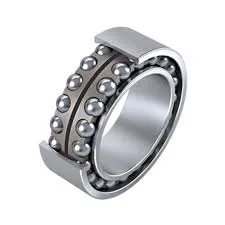
Nov . 05, 2024 14:48 Back to list
51106 thrust bearing
Understanding Thrust Bearings A Deep Dive into the 51106 Thrust Bearing
Thrust bearings are essential components in various mechanical systems, designed to support axial loads while enabling rotational motion. Among the various types of thrust bearings, the 51106 thrust bearing stands out due to its unique design and application versatility. This article explores the characteristics, applications, and advantages of the 51106 thrust bearing.
The 51106 thrust bearing is a type of flat thrust bearing, typically composed of a series of rolling elements—either balls or cylindrical rollers—positioned between two races
. The races are flat, enabling them to accommodate axial loads. The 51106 designation indicates specific dimensions and load capacity, making it crucial for engineers and designers to select the appropriate bearing for their applications.One of the defining features of the 51106 thrust bearing is its ability to handle relatively high axial loads while maintaining low friction. The rolling elements facilitate smooth operation, reducing wear and extending the bearing’s lifespan. The materials used in the construction of a 51106 bearing, often high-grade steel or ceramic, contribute to its durability and performance, ensuring consistent functionality even under extreme conditions.
51106 thrust bearing

The applications of the 51106 thrust bearing are diverse. They are commonly utilized in machinery that requires precise axial load support, such as automotive transmissions, electric motors, and various industrial equipment. In automotive applications, for example, thrust bearings are vital for supporting components like the crankshaft and transmission shafts, allowing them to rotate without excessive wear or failure. Moreover, these bearings can be found in rotary tables, pumps, and compressors, where axial space is limited but load-bearing capability is essential.
Choosing the right thrust bearing, such as the 51106, involves considering factors such as load capacity, speed, and operating environment. It is important to assess the maximum axial load the bearing will encounter and ensure that it matches or exceeds the bearing's specifications. Additionally, lubrication plays a crucial role in the performance of thrust bearings. Proper lubrication minimizes friction, dissipates heat, and collects debris, thereby prolonging the life of the bearing.
In conclusion, the 51106 thrust bearing is a fundamental tool in the realm of mechanical design, offering reliable support for axial loads across various applications. Its robust construction and efficient design make it suitable for a wide range of industries, from automotive to manufacturing. Engineers must carefully consider the specifications and operational requirements when selecting a thrust bearing to ensure optimal performance and longevity. As technology continues to advance, the development and innovation surrounding thrust bearings, including the 51106 model, will undoubtedly evolve, further enhancing their capabilities and applications.
Latest news
-
Durable Greenhouse Pillow Block Bearings for Reliable Ventilation
NewsAug.31,2025
-
Spherical Roller Bearings Applications: Heavy Duty, Self-Aligning
NewsAug.30,2025
-
Premium Deep Groove Ball Bearings | High Speed & Reliability
NewsAug.29,2025
-
Durable Scaffolding Clamps - Secure & Reliable Tube Connectors
NewsAug.28,2025
-
Common Failures in Thrust Ball Bearings and Solutions
NewsAug.22,2025
-
How Tapered Roller Bearings Can Take Shock Loads
NewsAug.22,2025
